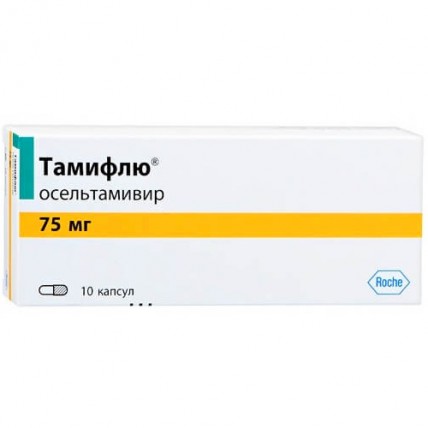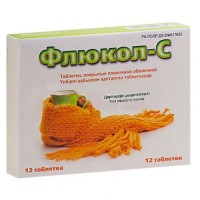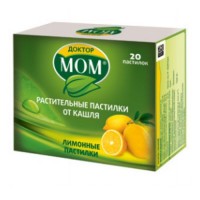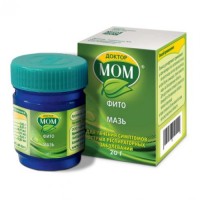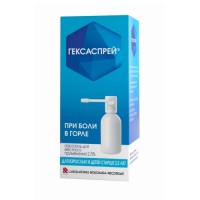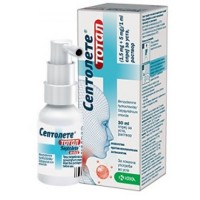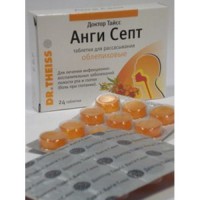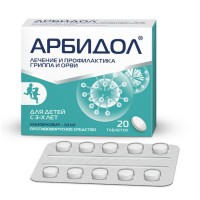Tamiflu® (Oseltamivir) 75 mg, 10 capsules
- $69.20
One capsule contains
After oral administration of oseltamivir, phosphate is readily absorbed from the gastrointestinal tract and is highly converted to the active metabolite by hepatic esterases. Plasma concentrations of the active metabolite are determined within 30 minutes, reach an almost maximum level 2–3 hours after ingestion, and significantly (more than 20 times) exceed the concentrations of the prodrug. At least 75% of the dose taken orally enters the systemic circulation in the form of an active metabolite, less than 5% - in the form of the parent drug. Plasma concentrations of both the prodrug and the active metabolite are dose-proportional and independent of food intake.
The mean volume of distribution (Vss) of the active metabolite is approximately 23 liters. The binding of the active metabolite to plasma proteins is negligible (about 3%). Plasma protein binding of the prodrug is 42%, which is insufficient to cause significant drug interactions.
Oseltamivir phosphate is highly converted to the active metabolite by esterases, which are predominantly in the liver and intestines. Neither oseltamivir phosphate nor the active metabolite are substrates or inhibitors of isoenzymes of the cytochrome P450 system.
Absorbed oseltamivir is eliminated primarily (>90%) by conversion to the active metabolite. The active metabolite does not undergo further transformation and is excreted in the urine (>99%). In most patients, the plasma half-life of the active metabolite is 6-10 hours. The active metabolite is eliminated completely (>99%) by renal excretion. Renal clearance (18.8 l / h) exceeds the glomerular filtration rate (7.5 l / h), which indicates that the drug is also excreted by tubular secretion. Less than 20% of the radioactively labeled drug taken orally is excreted in the feces.
Patients with kidney damage
When prescribing Tamiflu 100 mg 2 times a day for 5 days to patients with varying degrees of kidney damage, the area under the curve "plasma concentration of the active metabolite - time" (AUC) is inversely proportional to the decrease in kidney function. The pharmacokinetics of oseltamivir in patients with end-stage renal disease (creatinine clearance ≤10 ml/min) not on dialysis has not been studied.
Patients with liver damage
An in vitro study showed that in patients with hepatic disease, the AUC value of oseltamivir phosphate is not significantly increased, and the AUC of the active metabolite is not reduced.
Patients of senile age
In elderly patients (65-78 years old), the AUC of the active metabolite at steady state was 25-35% higher than in younger patients with similar doses of Tamiflu. The half-life of the drug in the elderly did not differ significantly from that in younger adult patients. Taking into account the data on the AUC of the drug and tolerability, dose adjustment in the treatment and prevention of influenza is not required in elderly patients.
Children
The pharmacokinetics of Tamiflu was studied in children 1 to 16 years of age in a single-dose pharmacokinetic study and in a clinical study in a small number of children aged 3-12 years. In young children, the elimination of the prodrug and the active metabolite was faster than in adults, resulting in lower AUC relative to a specific dose. Taking the drug at a dose of 2 mg / kg gives the same AUC of oseltamivir carboxylate, which is achieved in adults after a single dose of a capsule with 75 mg of the drug (equivalent to about 1 mg / kg). The pharmacokinetics of oseltamivir in children over 12 years of age is the same as in adults.
In children 6-12 months of age, the administration of oseltamivir at a dosage of 3 mg / kg twice a day provides a plasma level of the active metabolite, similar to the level demonstrating clinical efficacy in older children and adults.
Antiviral drug. Oseltamivir phosphate is a prodrug, its active metabolite (oseltamivir carboxylate) competitively and selectively inhibits neuraminidase of influenza A and B viruses, an enzyme that catalyzes the release of newly formed viral particles from infected cells, their penetration into the epithelial cells of the respiratory tract and further spread of the virus in the body.
Oseltamivir carboxylate acts outside of cells. It inhibits the growth of the influenza virus in vitro and suppresses the replication of the virus and its pathogenicity in vivo, reduces the release of influenza A and B viruses from the body. Its concentrations required to inhibit enzyme activity by 50% (IC50) are at the lower end of the nanomolar range.
When taking Tamiflu for the purpose of post-exposure (7 days) and seasonal (42 days) prevention of influenza, resistance to the drug is not observed.
The frequency of transient isolation of influenza virus with reduced sensitivity of neuraminidase to oseltamivir carboxylate in adult patients with influenza is 0.4%. Elimination of resistant virus from the body of patients receiving Tamiflu occurs without worsening the clinical condition of patients.
Tamiflu is taken by mouth, with or without food. In some patients, the tolerability of the drug improves if it is taken with food. Treatment should begin on the first or second day of flu symptoms.
In cases where adults, adolescents ≥12 years of age, and children weighing >40 kg or ≥8 years of age have difficulty swallowing capsules, open the capsule and pour the contents into a small amount (maximum 1 teaspoon) of a suitable sweetened food ( chocolate syrup (normal or no sugar), honey dissolved in water, sweet dessert, sweetened condensed milk, applesauce, or yogurt) to cover up the bitter taste. The mixture must be thoroughly mixed and given to the patient as a whole. The mixture should be swallowed immediately after preparation.
Adults and adolescents over 13 years of age (weighing over 40 kg):
Flu treatment:
The recommended dosing regimen for Tamiflu is 1 capsule 75 mg 2 times a day orally for 5 days or 75 mg suspension 2 times a day orally for 5 days.
Flu Prevention:
The recommended dose of Tamiflu for the prevention of influenza after contact with an infected person is 75 mg 1 time per day orally for 10 days.
The drug should be started no later than the first 2 days after contact.
The recommended dose for prophylaxis during a seasonal influenza epidemic is 75 mg once a day; shows the efficacy and safety of the drug when taken for 6 weeks. The prophylactic effect lasts as long as the drug is taken.
Children from 1 year to 12 years:
Flu treatment:
Flu Prevention:
The effectiveness of Tamiflu for prophylaxis during a seasonal influenza epidemic in children under 12 years of age has not been studied.
Children under 1 year old
Flu treatment:
The recommended dose for children under 1 year of age is 3 mg/kg body weight twice a day.
This dosing regimen is not applicable to preterm infants (i.e., born before 36 weeks). There are insufficient data on dosing in this group of patients.
Flu Prevention:
The recommended dose of Tamiflu for the prevention of influenza during a pandemic in children under 1 year of age is half the therapeutic dose of 3 mg/kg once daily for 10 days. The effectiveness of Tamiflu for prophylaxis during a seasonal influenza epidemic in children under 1 year of age has not been studied.
Patients with kidney damage
Flu treatment. Patients with a creatinine clearance of more than 30 ml / min dose adjustment is not required. In patients with creatinine clearance between 10 and 30 ml/min, the dose of Tamiflu should be reduced to 75 mg once daily for 5 days.
For patients on chronic hemodialysis, Tamiflu may be prescribed at a dose of 30 mg before a dialysis session. To maintain plasma concentrations of oseltamivir, Tamiflu 30 mg should be administered after each hemodialysis session. In peritoneal dialysis, Tamiflu is prescribed at a dose of 30 mg before a dialysis session, and then for 5 days at 30 mg per day. In patients with end-stage chronic renal failure (creatinine clearance less than 10 ml / min) who are not on hemodialysis, the pharmacokinetics of oseltamivir has not been studied.
Flu prevention. Patients with a creatinine clearance of more than 30 ml / min dose adjustment is not required. In patients with creatinine clearance between 10 and 30 ml/min, the dose of Tamiflu should be reduced to 75 mg every other day or to 30 mg every other day. For patients on chronic hemodialysis, Tamiflu may be prescribed at a dose of 30 mg before a dialysis session. To maintain plasma concentrations of oseltamivir, Tamiflu 30 mg should be administered through a single hemodialysis session, at the end of the procedure. In peritoneal dialysis, Tamiflu is prescribed at a dose of 30 mg before a dialysis session, and then every 7 days, 30 mg.
Patients with liver damage
Dose adjustment in the treatment and prevention of influenza is not required.
Elderly patients
Dose adjustment in the treatment and prevention of influenza is not required.
Extemporaneous preparation of Tamiflu
In cases where adults, adolescents and children have a problem with swallowing capsules, and Tamiflu in the dosage form "powder for oral suspension" is not available or if there are signs of "aging" of the capsules, it is necessary to open the capsule and pour its contents into a small amount (maximum 1 teaspoon) of a suitable sweetened food item to cover the bitter taste. The mixture must be thoroughly mixed and given to the patient as a whole. The mixture should be swallowed immediately after preparation.
If patients require a dose of 75 mg, then the following instructions should be followed:
1. Holding one Tamiflu 75mg capsule over a small container, carefully open the capsule and pour the powder into the container.
2. Add a small amount (no more than 1 teaspoon) of a suitable sweetened food item (to cover the bitter taste) and mix well.
3. Thoroughly mix the mixture and drink it immediately after preparation. If a small amount of the mixture remains in the container, then rinse the container with a small amount of water and drink the remaining mixture.
If patients require doses of 30-60 mg, then the following instructions should be followed for correct dosing:
1. Holding one Tamiflu 75mg capsule over a small container, carefully open the capsule and pour the powder into the container.
2. Add 5 ml of water to the powder using a syringe with marks indicating the amount of liquid collected. Mix thoroughly for 2 minutes.
3. Draw the required amount of the mixture from the container into the syringe according to the table below:
There is no need to collect the undissolved white powder as it is an inactive excipient. By pressing the plunger of the syringe, inject all its contents into the second container. The remaining unused mixture must be discarded.
4. In the second container, add a small amount (no more than 1 teaspoon) of a suitable sweetened food item to cover the bitter taste and mix well.
5. Thoroughly mix the mixture and drink it immediately after preparation. If a small amount of the mixture remains in the container, then rinse the container with a small amount of water and drink the remaining mixture.
Very often ( > 10%)
- nausea, vomiting
- headache
Often ( 1-10 % )
- back pain
- cough, nosebleeds, nasal congestion, nasopharyngitis, bronchitis, otitis media, sinusitis, bronchospasm,
- diarrhea, pain in the epigastric region
- herpes
- irritability, fatigue
Uncommon (1-0.1%)
- insomnia
- allergic reactions (dermatitis)
- conjunctivitis
- lymphadenopathy
Rare (<0.1%)
- hypersensitivity reactions (including dermatitis, rash, eczema, erythema multiforme, anaphylactic reactions), Stevens-Johnson syndrome
- gastrointestinal bleeding
- hepatitis, increased levels of liver enzymes
- convulsions, delirious states, overexcitation.
- hypersensitivity to oseltamivir phosphate or any component of the drug
- chronic renal failure (permanent hemodialysis, chronic peritoneal dialysis, creatinine clearance ≤10 ml/min)
Information obtained from pharmacological and pharmacokinetic studies of oseltamivir phosphate suggests that clinically significant drug interactions are unlikely.
Drug interactions due to competition and binding to the active sites of esterases that convert oseltamivir phosphate into the active substance are not covered in detail in the literature. The low degree of binding of oseltamivir and the active metabolite to proteins does not suggest the presence of interactions associated with the displacement of drugs from protein binding.
Neither oseltamivir phosphate nor the active metabolite is the preferred substrate for polyfunctional oxidases of the cytochrome P450 system or for glucuronyltransferases. There is no formal basis for interaction with oral contraceptives.
Cimetidine, a non-specific inhibitor of cytochrome P450 isoenzymes, does not affect the plasma concentrations of oseltamivir and its active metabolite.
Clinically significant drug-drug interactions associated with competition for tubular secretion are unlikely, given the margin of safety for most of these drugs, the routes of elimination of the active metabolite of oseltamivir (glomerular filtration and anionic tubular secretion), and the excretion capacity of each of the routes.
The simultaneous appointment of probenecid leads to an increase in the AUC of the active metabolite by about 2 times. However, dose adjustment is not required when co-administered with probenecid.
Simultaneous administration with amoxicillin does not affect the plasma concentrations of both drugs. Pharmacokinetic interactions between oseltamivir, its main metabolite, were not found when taken simultaneously with paracetamol, acetylsalicylic acid, cimetidine, or antacids (magnesium and aluminum hydroxide, calcium carbonate).
When prescribing Tamiflu together with commonly used drugs such as ACE inhibitors (enalapril, captopril), thiazide diuretics, antibiotics (penicillin, cephalosporins, azithromycin, erythromycin and doxycycline), histamine H2 receptor blockers (ranitidine, cimetidine), beta-blockers (propranolol), xanthines (theophylline), sympathomimetics (pseudoephedrine), opiates (codeine), corticosteroids, inhaled bronchodilators and analgesics (aspirin, ibuprofen and paracetamol), no changes in the nature or frequency of adverse events were observed.
There are no data on the effectiveness of Tamiflu in any diseases caused by pathogens other than influenza A and B viruses.
Childhood
Children under 13 years of age weighing less than 40 kg are recommended to use Tamiflu powder for oral suspension.
Children 6-12 months of age: The effectiveness of Tamiflu in children under 1 year of age has not been established. However, there are limited pharmacokinetic data in children 6–12 months of age, suggesting that oseltamivir 3 mg/kg twice daily provides plasma levels of the active metabolite similar to those seen clinically in older children and adults.
Pregnancy and lactation
Controlled clinical studies evaluating the safety of Tamiflu in pregnant women have not been conducted. Tamiflu should be used during pregnancy or lactation only if the possible benefits of its use outweigh the potential risk to the fetus or infant and an assessment has been made of the safety, pathogenicity of a particular strain of influenza virus and the health of the pregnant woman.
Features of influence on the ability to drive vehicles or potentially dangerous mechanisms
Does not affect
Currently, no cases of overdose have been described, however, the expected symptoms of acute overdose will be nausea with or without vomiting. Single doses of Tamiflu up to 1000 mg were well tolerated, with the exception of nausea and vomiting.
Store at a temperature not exceeding 25 °C.
Keep out of the reach of children!
Shelf life - 7 years
Do not use after the expiry date stated on the packaging.
- Active ingredient - Oseltamivir phosphate 98.50 (equivalent to oseltamivir) (75.00)
- Excipients: pregelatinized starch, povidone K30, croscarmellose sodium, talc, sodium stearyl fumarate
Pharmacological properties
Pharmacokinetics
After oral administration of oseltamivir, phosphate is readily absorbed from the gastrointestinal tract and is highly converted to the active metabolite by hepatic esterases. Plasma concentrations of the active metabolite are determined within 30 minutes, reach an almost maximum level 2–3 hours after ingestion, and significantly (more than 20 times) exceed the concentrations of the prodrug. At least 75% of the dose taken orally enters the systemic circulation in the form of an active metabolite, less than 5% - in the form of the parent drug. Plasma concentrations of both the prodrug and the active metabolite are dose-proportional and independent of food intake.
The mean volume of distribution (Vss) of the active metabolite is approximately 23 liters. The binding of the active metabolite to plasma proteins is negligible (about 3%). Plasma protein binding of the prodrug is 42%, which is insufficient to cause significant drug interactions.
Oseltamivir phosphate is highly converted to the active metabolite by esterases, which are predominantly in the liver and intestines. Neither oseltamivir phosphate nor the active metabolite are substrates or inhibitors of isoenzymes of the cytochrome P450 system.
Absorbed oseltamivir is eliminated primarily (>90%) by conversion to the active metabolite. The active metabolite does not undergo further transformation and is excreted in the urine (>99%). In most patients, the plasma half-life of the active metabolite is 6-10 hours. The active metabolite is eliminated completely (>99%) by renal excretion. Renal clearance (18.8 l / h) exceeds the glomerular filtration rate (7.5 l / h), which indicates that the drug is also excreted by tubular secretion. Less than 20% of the radioactively labeled drug taken orally is excreted in the feces.
Pharmacokinetics in special groups
Patients with kidney damage
When prescribing Tamiflu 100 mg 2 times a day for 5 days to patients with varying degrees of kidney damage, the area under the curve "plasma concentration of the active metabolite - time" (AUC) is inversely proportional to the decrease in kidney function. The pharmacokinetics of oseltamivir in patients with end-stage renal disease (creatinine clearance ≤10 ml/min) not on dialysis has not been studied.
Patients with liver damage
An in vitro study showed that in patients with hepatic disease, the AUC value of oseltamivir phosphate is not significantly increased, and the AUC of the active metabolite is not reduced.
Patients of senile age
In elderly patients (65-78 years old), the AUC of the active metabolite at steady state was 25-35% higher than in younger patients with similar doses of Tamiflu. The half-life of the drug in the elderly did not differ significantly from that in younger adult patients. Taking into account the data on the AUC of the drug and tolerability, dose adjustment in the treatment and prevention of influenza is not required in elderly patients.
Children
The pharmacokinetics of Tamiflu was studied in children 1 to 16 years of age in a single-dose pharmacokinetic study and in a clinical study in a small number of children aged 3-12 years. In young children, the elimination of the prodrug and the active metabolite was faster than in adults, resulting in lower AUC relative to a specific dose. Taking the drug at a dose of 2 mg / kg gives the same AUC of oseltamivir carboxylate, which is achieved in adults after a single dose of a capsule with 75 mg of the drug (equivalent to about 1 mg / kg). The pharmacokinetics of oseltamivir in children over 12 years of age is the same as in adults.
In children 6-12 months of age, the administration of oseltamivir at a dosage of 3 mg / kg twice a day provides a plasma level of the active metabolite, similar to the level demonstrating clinical efficacy in older children and adults.
Pharmacodynamics
Antiviral drug. Oseltamivir phosphate is a prodrug, its active metabolite (oseltamivir carboxylate) competitively and selectively inhibits neuraminidase of influenza A and B viruses, an enzyme that catalyzes the release of newly formed viral particles from infected cells, their penetration into the epithelial cells of the respiratory tract and further spread of the virus in the body.
Oseltamivir carboxylate acts outside of cells. It inhibits the growth of the influenza virus in vitro and suppresses the replication of the virus and its pathogenicity in vivo, reduces the release of influenza A and B viruses from the body. Its concentrations required to inhibit enzyme activity by 50% (IC50) are at the lower end of the nanomolar range.
When taking Tamiflu for the purpose of post-exposure (7 days) and seasonal (42 days) prevention of influenza, resistance to the drug is not observed.
The frequency of transient isolation of influenza virus with reduced sensitivity of neuraminidase to oseltamivir carboxylate in adult patients with influenza is 0.4%. Elimination of resistant virus from the body of patients receiving Tamiflu occurs without worsening the clinical condition of patients.
Indications for use
- Teatment of influenza in adults and children, including term newborns, who develop influenza symptoms when the influenza virus is circulating in the community. Efficacy has been demonstrated when starting treatment within 2 days of the first onset of influenza symptoms.
- Prevention of influenza in adults and children:
- Prophylaxis of influenza in adults and children over 1 year of age after exposure to clinically confirmed influenza cases when the influenza virus is circulating in the population
- Prevention of influenza in children under 1 year of age during an influenza pandemic.
Dosage and administration
Tamiflu is taken by mouth, with or without food. In some patients, the tolerability of the drug improves if it is taken with food. Treatment should begin on the first or second day of flu symptoms.
In cases where adults, adolescents ≥12 years of age, and children weighing >40 kg or ≥8 years of age have difficulty swallowing capsules, open the capsule and pour the contents into a small amount (maximum 1 teaspoon) of a suitable sweetened food ( chocolate syrup (normal or no sugar), honey dissolved in water, sweet dessert, sweetened condensed milk, applesauce, or yogurt) to cover up the bitter taste. The mixture must be thoroughly mixed and given to the patient as a whole. The mixture should be swallowed immediately after preparation.
Standard dosing regimen
Adults and adolescents over 13 years of age (weighing over 40 kg):
Flu treatment:
The recommended dosing regimen for Tamiflu is 1 capsule 75 mg 2 times a day orally for 5 days or 75 mg suspension 2 times a day orally for 5 days.
Flu Prevention:
The recommended dose of Tamiflu for the prevention of influenza after contact with an infected person is 75 mg 1 time per day orally for 10 days.
The drug should be started no later than the first 2 days after contact.
The recommended dose for prophylaxis during a seasonal influenza epidemic is 75 mg once a day; shows the efficacy and safety of the drug when taken for 6 weeks. The prophylactic effect lasts as long as the drug is taken.
Children from 1 year to 12 years:
Flu treatment:
| Body mass | Recommended dosage for 5 days: |
| 10 - 15 kg | 30 mg twice a day |
| 15 - 23 kg | 45 mg twice a day |
| 23 - 40 kg | 60 mg twice a day |
| > 40 kg | 75 mg twice a day |
Flu Prevention:
| Body mass | Recommended dosage for 10 days: |
| 10 - 15 kg | 30 mg once a day |
| 15 - 23 kg | 45 mg once a day |
| 23 - 40 kg | 60 mg once a day |
| > 40 kg | 75 mg once a day |
The effectiveness of Tamiflu for prophylaxis during a seasonal influenza epidemic in children under 12 years of age has not been studied.
Children under 1 year old
Flu treatment:
The recommended dose for children under 1 year of age is 3 mg/kg body weight twice a day.
| Body mass | Recommended dosage for 5 days: |
| 3 kg | 9 mg twice a day |
| 4 kg | 12 mg twice a day |
| 5 kg | 15 mg twice a day |
| 6 kg | 18 mg twice a day |
| 7 kg | 21 mg twice a day |
| 8 kg | 24 mg twice a day |
| 9 kg | 27 mg twice a day |
| 10 kg | 30 mg twice a day |
This dosing regimen is not applicable to preterm infants (i.e., born before 36 weeks). There are insufficient data on dosing in this group of patients.
Flu Prevention:
The recommended dose of Tamiflu for the prevention of influenza during a pandemic in children under 1 year of age is half the therapeutic dose of 3 mg/kg once daily for 10 days. The effectiveness of Tamiflu for prophylaxis during a seasonal influenza epidemic in children under 1 year of age has not been studied.
Dosing in special cases
Patients with kidney damage
Flu treatment. Patients with a creatinine clearance of more than 30 ml / min dose adjustment is not required. In patients with creatinine clearance between 10 and 30 ml/min, the dose of Tamiflu should be reduced to 75 mg once daily for 5 days.
For patients on chronic hemodialysis, Tamiflu may be prescribed at a dose of 30 mg before a dialysis session. To maintain plasma concentrations of oseltamivir, Tamiflu 30 mg should be administered after each hemodialysis session. In peritoneal dialysis, Tamiflu is prescribed at a dose of 30 mg before a dialysis session, and then for 5 days at 30 mg per day. In patients with end-stage chronic renal failure (creatinine clearance less than 10 ml / min) who are not on hemodialysis, the pharmacokinetics of oseltamivir has not been studied.
Flu prevention. Patients with a creatinine clearance of more than 30 ml / min dose adjustment is not required. In patients with creatinine clearance between 10 and 30 ml/min, the dose of Tamiflu should be reduced to 75 mg every other day or to 30 mg every other day. For patients on chronic hemodialysis, Tamiflu may be prescribed at a dose of 30 mg before a dialysis session. To maintain plasma concentrations of oseltamivir, Tamiflu 30 mg should be administered through a single hemodialysis session, at the end of the procedure. In peritoneal dialysis, Tamiflu is prescribed at a dose of 30 mg before a dialysis session, and then every 7 days, 30 mg.
Patients with liver damage
Dose adjustment in the treatment and prevention of influenza is not required.
Elderly patients
Dose adjustment in the treatment and prevention of influenza is not required.
Extemporaneous preparation of Tamiflu
In cases where adults, adolescents and children have a problem with swallowing capsules, and Tamiflu in the dosage form "powder for oral suspension" is not available or if there are signs of "aging" of the capsules, it is necessary to open the capsule and pour its contents into a small amount (maximum 1 teaspoon) of a suitable sweetened food item to cover the bitter taste. The mixture must be thoroughly mixed and given to the patient as a whole. The mixture should be swallowed immediately after preparation.
If patients require a dose of 75 mg, then the following instructions should be followed:
1. Holding one Tamiflu 75mg capsule over a small container, carefully open the capsule and pour the powder into the container.
2. Add a small amount (no more than 1 teaspoon) of a suitable sweetened food item (to cover the bitter taste) and mix well.
3. Thoroughly mix the mixture and drink it immediately after preparation. If a small amount of the mixture remains in the container, then rinse the container with a small amount of water and drink the remaining mixture.
If patients require doses of 30-60 mg, then the following instructions should be followed for correct dosing:
1. Holding one Tamiflu 75mg capsule over a small container, carefully open the capsule and pour the powder into the container.
2. Add 5 ml of water to the powder using a syringe with marks indicating the amount of liquid collected. Mix thoroughly for 2 minutes.
3. Draw the required amount of the mixture from the container into the syringe according to the table below:
| Body mass | Recommended dose | Amount of Tamiflu® mixture per dose |
| £15 kg | 30 mg | 2 ml |
| >15-23 kg | 45 mg | 3 ml |
| >23-40 kg | 60 mg | 4 ml |
There is no need to collect the undissolved white powder as it is an inactive excipient. By pressing the plunger of the syringe, inject all its contents into the second container. The remaining unused mixture must be discarded.
4. In the second container, add a small amount (no more than 1 teaspoon) of a suitable sweetened food item to cover the bitter taste and mix well.
5. Thoroughly mix the mixture and drink it immediately after preparation. If a small amount of the mixture remains in the container, then rinse the container with a small amount of water and drink the remaining mixture.
Side effects
Very often ( > 10%)
- nausea, vomiting
- headache
Often ( 1-10 % )
- back pain
- cough, nosebleeds, nasal congestion, nasopharyngitis, bronchitis, otitis media, sinusitis, bronchospasm,
- diarrhea, pain in the epigastric region
- herpes
- irritability, fatigue
Uncommon (1-0.1%)
- insomnia
- allergic reactions (dermatitis)
- conjunctivitis
- lymphadenopathy
Rare (<0.1%)
- hypersensitivity reactions (including dermatitis, rash, eczema, erythema multiforme, anaphylactic reactions), Stevens-Johnson syndrome
- gastrointestinal bleeding
- hepatitis, increased levels of liver enzymes
- convulsions, delirious states, overexcitation.
Contraindications
- hypersensitivity to oseltamivir phosphate or any component of the drug
- chronic renal failure (permanent hemodialysis, chronic peritoneal dialysis, creatinine clearance ≤10 ml/min)
Drug Interactions
Information obtained from pharmacological and pharmacokinetic studies of oseltamivir phosphate suggests that clinically significant drug interactions are unlikely.
Drug interactions due to competition and binding to the active sites of esterases that convert oseltamivir phosphate into the active substance are not covered in detail in the literature. The low degree of binding of oseltamivir and the active metabolite to proteins does not suggest the presence of interactions associated with the displacement of drugs from protein binding.
Neither oseltamivir phosphate nor the active metabolite is the preferred substrate for polyfunctional oxidases of the cytochrome P450 system or for glucuronyltransferases. There is no formal basis for interaction with oral contraceptives.
Cimetidine, a non-specific inhibitor of cytochrome P450 isoenzymes, does not affect the plasma concentrations of oseltamivir and its active metabolite.
Clinically significant drug-drug interactions associated with competition for tubular secretion are unlikely, given the margin of safety for most of these drugs, the routes of elimination of the active metabolite of oseltamivir (glomerular filtration and anionic tubular secretion), and the excretion capacity of each of the routes.
The simultaneous appointment of probenecid leads to an increase in the AUC of the active metabolite by about 2 times. However, dose adjustment is not required when co-administered with probenecid.
Simultaneous administration with amoxicillin does not affect the plasma concentrations of both drugs. Pharmacokinetic interactions between oseltamivir, its main metabolite, were not found when taken simultaneously with paracetamol, acetylsalicylic acid, cimetidine, or antacids (magnesium and aluminum hydroxide, calcium carbonate).
When prescribing Tamiflu together with commonly used drugs such as ACE inhibitors (enalapril, captopril), thiazide diuretics, antibiotics (penicillin, cephalosporins, azithromycin, erythromycin and doxycycline), histamine H2 receptor blockers (ranitidine, cimetidine), beta-blockers (propranolol), xanthines (theophylline), sympathomimetics (pseudoephedrine), opiates (codeine), corticosteroids, inhaled bronchodilators and analgesics (aspirin, ibuprofen and paracetamol), no changes in the nature or frequency of adverse events were observed.
Special instructions
There are no data on the effectiveness of Tamiflu in any diseases caused by pathogens other than influenza A and B viruses.
Childhood
Children under 13 years of age weighing less than 40 kg are recommended to use Tamiflu powder for oral suspension.
Children 6-12 months of age: The effectiveness of Tamiflu in children under 1 year of age has not been established. However, there are limited pharmacokinetic data in children 6–12 months of age, suggesting that oseltamivir 3 mg/kg twice daily provides plasma levels of the active metabolite similar to those seen clinically in older children and adults.
Pregnancy and lactation
Controlled clinical studies evaluating the safety of Tamiflu in pregnant women have not been conducted. Tamiflu should be used during pregnancy or lactation only if the possible benefits of its use outweigh the potential risk to the fetus or infant and an assessment has been made of the safety, pathogenicity of a particular strain of influenza virus and the health of the pregnant woman.
Features of influence on the ability to drive vehicles or potentially dangerous mechanisms
Does not affect
Overdose
Currently, no cases of overdose have been described, however, the expected symptoms of acute overdose will be nausea with or without vomiting. Single doses of Tamiflu up to 1000 mg were well tolerated, with the exception of nausea and vomiting.
Storage conditions
Store at a temperature not exceeding 25 °C.
Keep out of the reach of children!
Shelf life - 7 years
Do not use after the expiry date stated on the packaging.
